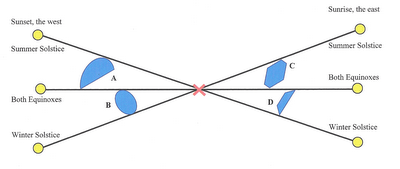My favorite new idea is connected to the cycle of the sun, as it appears from earth to swing to the north in summer and back to the south in winter. The sky has always been the steadiest phenomenon that we can observe from earth. And the predictable swing of declination is a natural and obvious way to mark the turning of the years, especially for ancient peoples, who spent so much more of their life immersed in their natural environment.
In the diagram below, the red 'x' is where a person might stand, and the yellow circles represent sunrise and sunset at different times of year. The lines that cross through the whole image are sighting lines, and the blue shapes are our imaginary stones. This is where we start paying attention to efficient thinking, because we sure don't want to move these twelve-ton monsters twice.

Having taken the time to observe for a year or more as the sun swings in its predictable pattern, our imaginary priestess has marked the points of highest and lowest declination. And being such a clever girl, she has also deduced that these points represent the height of summer and the longest night of winter. Now she wants to mark these special points for future generations. So she calls council, and the tribe prepares for some intense community effort. They choose four stones, large and slow wearing, but not any particular shape, and they drag them into position.
Now for the elegance of it. Whatever size the cross section of the stones, they will serve our priestess's purpose. All she does is sight along her markers and make certain that the edges of the stones just touch the lines of sight. Big stones go farther out, little stones go closer to center, wherever they need to be to touch the lines. Four stones! The village groans, but band together for the sake of posterity. And soon, they are set just so.
Then our priestess points out the perfection of her design. With just these four stones, they can mark sunset and sunrise for all four of the major turnings of the year. Four stones, eight time markers. By standing outside all four stones and sighting back through them, each special sunrise and sunset is given a narrow window of display.
Standing southwest of stone B and looking back toward our center mark, you can see only stones and a tiny sliver of sky. That sliver is where the sun will rise on summer solstice. And so forth with the other solar events.
I so look forward to recreating this. Do you own a piece of land with a good view of the horizon? Do you want to mark the turning of the seasons with stones or sculpture? I'm your girl!
Namaste,
Crow
No comments:
Post a Comment